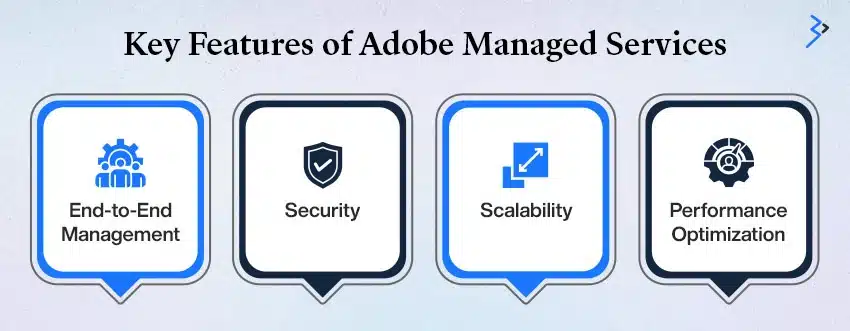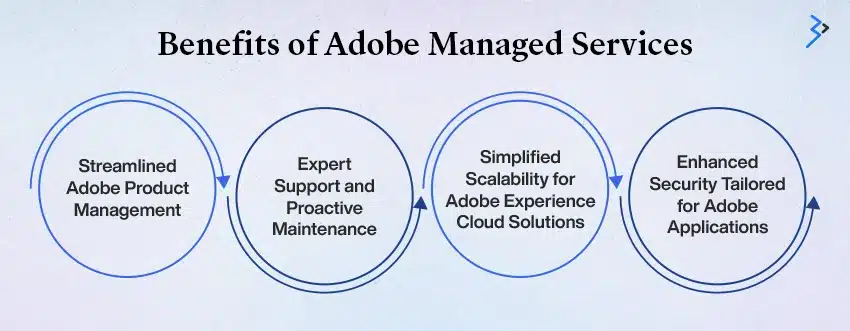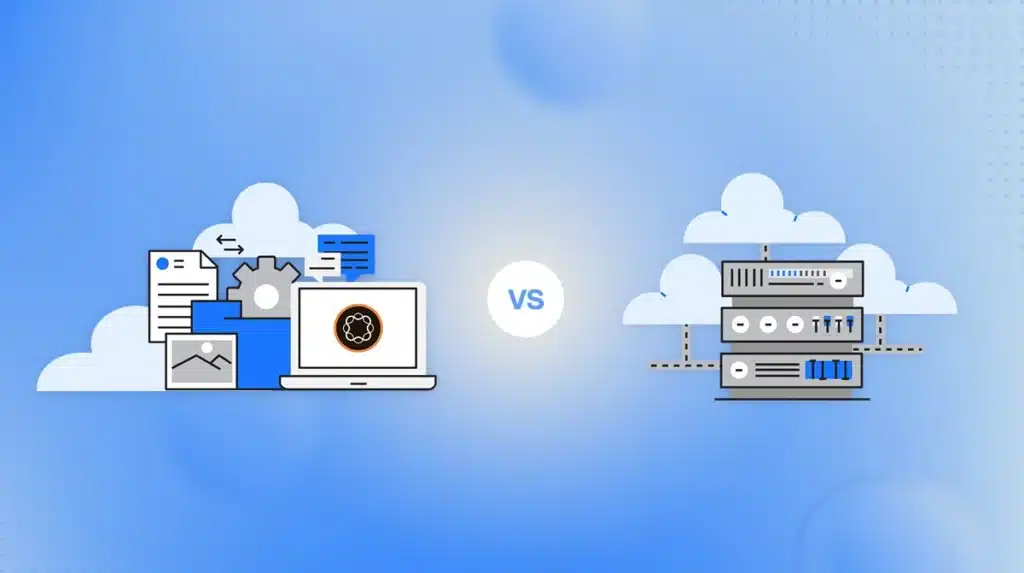Summary:
In today’s fast-paced digital landscape, deciding on the right service model is critical for businesses that hope to deliver exceptional customer experiences and stay ahead of the competition.
Whether your business is growing or highly scaled, the right solution often determines efficiency, scalability, and overall success—certainly in e-commerce businesses. Two powerful options have emerged among the array of options available: Adobe Managed Services (AMS) and generic cloud services, each with distinct benefits.
This article focuses on helping e-commerce businesses navigate this important decision-making process by exploring the role of Adobe Experience Cloud Managed Services for eCommerce businesses.
We’ll examine AMS’s tailored approach to Adobe Experience Cloud and compare it with generic cloud services to highlight which solution better meets your business needs.
Here’s what you will be learning:
- What are Adobe Managed Services and Generic Cloud Services?
- Key Features and Benefits of AMS
- Comparing Scalability, Customization, and Cost
By the end of this article, you will have a clearer understanding of these two service models and how to select the one that best suits your eCommerce goals.
What Are Adobe Managed Services?
Adobe Managed Services, also abbreviated AMS, is an integrated, cloud-based solution designed to assist businesses in managing, optimizing, and scaling the Adobe Experience Cloud applications. Its end-to-end management for Adobe solutions reduces complexity while it is available for the smooth integration of the AMS for high performance and strong security.
Integration with Adobe Experience Cloud Products
AMS collaborates fluently with other Adobe Experience Cloud products like Adobe Analytics Services, Target, and Commerce Managed Services. This connection helps organizations provide customer-centric experiences with excellent system performance and reliability. AMS manages the technical backend, so businesses can focus on leveraging these tools for growth.
Key Features of Adobe Managed Services

- End-to-End Management
AMS provides complete management of your Adobe applications, from implementation to monitoring and updates, minimizing the burden on in-house IT teams. - Security
AMS ensures the safety of sensitive customer data through robust security measures, including data encryption and compliance with global standards. - Scalability
As your business grows, AMS allows your systems to scale effortlessly, accommodating increased traffic and demand. - Performance Optimization
AMS emphasizes delivering a smooth user experience by ensuring that applications run smoothly and efficiently, with expert monitoring and support.
Who Can Benefit from Adobe Managed Services?

AMS is best suited for businesses of any size looking to improve their digital capabilities without the burden of managing complex IT infrastructure. For instance:
- E-commerce companies using Adobe Commerce managed services enjoy high availability, scalability during peak sales, and secure payment handling.
- The retail and hospitality industries can leverage AMS toward personalized experiences and greater customer knowledge.
What Are Cloud Services?
Cloud services are a type of computing service provided over the Internet. Many businesses and individuals use the cloud to store data and applications on the go without any in-house infrastructure. Large companies, such as Amazon Web Services, Microsoft Azure, and Google Cloud, offer scalable, flexible solutions to all required business needs.
Types of Cloud Services
- Software as a Service (SaaS): This refers to software applications one accesses through the internet. Examples of SaaS are Google Workspace, Dropbox, and Adobe Managed Cloud Services. With SaaS, there is no installation or maintenance of software on computers.
- Platform as a Service (PaaS) provides a platform that enables customers to develop, run, and manage applications without worrying about the underlying infrastructure. Examples of PaaS include Microsoft Azure and Google App Engine.
- Infrastructure as a Service, or IaaS: It delivers virtualized computing resources to businesses through the Internet. This offers more flexibility and cost-effectiveness. AWS EC2 and Microsoft Azure Cloud Services are prominent examples.
Example of Businesses Using Cloud Services
Most firms, including small and even big organizations, rely on cloud services to perform everyday business. Such businesses include e-commerce websites, digital marketing companies, and other technological ventures whose activities are based on improvements facilitated by cloud services.
Additionally, Adobe Managed Support offers businesses tailored cloud-based solutions for better management of Adobe products, ensuring that companies maximize their software investments.
Key Differences Between Adobe Managed Services and Cloud Services
Choosing between AMS and Cloud Services involves businesses weighing several very important factors. Each is unique, but in terms of which one is usually preferred, it usually lies in the needs, competency, and scale of a business operation. Let’s break the differences down into several critical areas:
Infrastructure and Management
- Adobe Managed Services (AMS):
- Adobe fully manages AMS, ensuring seamless integration with Adobe’s suite of tools, including Adobe Commerce Managed Hosting.
- Adobe handles infrastructure setup, software installation, and management, so businesses don’t need an in-house team for ongoing maintenance and optimization.
- AMS is designed to work flawlessly with Adobe Experience Cloud products, making it ideal for businesses already using these tools extensively.
- Cloud Services:
- Cloud services, on the other hand, are typically more flexible. While cloud service providers offer robust infrastructure, businesses must handle their integration and customization.
- Cloud services require in-house teams or third-party vendors to ensure everything runs smoothly and integrates with other business applications.
- This allows for broader use cases, making it suitable for businesses with a diverse tech stack that may extend beyond Adobe’s ecosystem.
Security
- AMS:
- Security is a core part of Adobe’s offering with AMS. Adobe takes full responsibility for securing its products, offering built-in protection measures and compliance with industry standards.
- This means businesses using AMS can rely on Adobe’s robust security frameworks, minimizing the need for their security management.
- Cloud Services:
- Cloud-based solutions usually leave security to either the business or a third-party vendor. Most cloud service providers offer securities, but businesses must manage and tailor these layers to their needs.
- This might include integrating additional security tools, setting up a firewall, and staying abreast of all applicable regulations requiring higher expertise.
Customization
- AMS:
- Adobe Managed Services are tailored for Adobe solutions, which means customization options are limited to the Adobe ecosystem.
- While there is some flexibility in how businesses can use and configure Adobe tools, AMS is not designed for highly customized or non-Adobe environments.
- Cloud Services:
- Cloud services can be very tailor-made according to the necessities and wide range of requirements from various industries.
- Whether one requires customized solutions or wants integrations with many other software tools, cloud services can alter all the infrastructures, applications, and performance based on business needs.
Costs of Operation
- AMS:
- Adobe Managed Services typically operates on a subscription-based model, with premium pricing due to Adobe’s high level of management and integration.
- While the costs may be higher, businesses benefit from a hassle-free experience and dedicated support.
- Cloud Services:
- Cloud services usually use a pay-as-you-go pricing model. Customers enjoy flexibility in pricing but must incur costs due to additional investment in servicing their companies.
- While scaling may not be costly for cloud services, it also means budgeting for IT expertise or third-party vendors to support the infrastructure and integrations.
Performance and Scalability
- AMS:
- AMS integrates to scale performance with various Adobe-related products, increasing performance using applications based on Adobe Experience Cloud or other solutions.
- It is good in those areas but may not be as flexible for wider business applications.
- Cloud Services:
- Cloud services offer greater scalability across a wide range of business applications. Whether you need to scale your website, add analytics resources, or include third-party applications, cloud services can handle all these needs.
- Cloud solutions are suitable for large businesses that want to evolve beyond one integrated set of products by utilizing various available products.
Support
- AMS:
- AMS comes with Adobe’s dedicated support team. Businesses using AMS can rely on Adobe’s expertise to resolve issues related to their products or hosting environment.
- This support is often included as part of the service, making it convenient for companies that prefer a streamlined support experience.
- Cloud Services:
- Cloud service support depends on the chosen provider. Most cloud service providers offer customer support, which may require additional contracts or SLAs.
- Businesses that provide specific services may have third-party vendors or specialized IT teams.
Use Cases
- AMS:
- AMS is best suited for businesses that rely heavily on Adobe Experience Cloud tools or need Adobe Commerce Managed Hosting for a robust eCommerce platform.
- It’s ideal for companies that want a managed service with minimal fuss, especially those deeply integrated into Adobe’s ecosystem.
- Cloud Services:
- Cloud services are more appropriate for businesses with diverse technology needs that may cut across multiple industries or require the integration of various software solutions.
- Cloud services will benefit companies that require flexibility, scalability, and customization of their technology stack to meet different business challenges.
Here’s a chart to help you better understand the difference between the solutions:
| Nature of Difference | Adobe Managed Service | Cloud Services |
| Infrastructure & Management | Adobe is fully responsible for managing your business operations. | It’s a more flexible option with the presence of multiple third-party integrations. |
| Security | Access to built-in protection measures and compliance with industry standards. | The business or a third-party vendor generally manages security. |
| Customization | Offers customization limited tothe Adobe ecosystem. | Access to complete customization as per unique requirements of business owners. |
| Costs of Operation | Users need to pay a fixed service subscription. | It’s based on a pay-as-you-go model, where organizations pay based on usage. |
| Performance and Scalability | Access to different Adobe integrations that enhance performance and ensure scalability of operations. | It offers better scalability than Adobe Managed Services. |
| Support | 24/7 dedicated team to offer instant user support. | The type of service depends on the chosen provider. |
Benefits of Adobe Managed Services
Adobe Managed Services offers a range of advantages that can significantly enhance your business operations. Here’s how:
Streamlined Adobe Product Management
Adobe Managed Services simplifies the administration of Adobe products, ensuring their smooth operation. Thus, you can focus on creative and business priorities while leaving technical management to experts.
Expert Support and Proactive Maintenance
Access a team of professionals for ongoing support and proactive maintenance with Adobe Managed Services: reduce downtime, address potential issues before they arise, and keep your Adobe solutions performing at their best.
Simplified Scalability for Adobe Experience Cloud Solutions
Adobe Managed Services ensures that your solutions scale seamlessly as your business grows. Whether you need more storage, additional features, or expanded capabilities, scaling up becomes effortless, supported by Adobe’s cloud infrastructure.
Enhanced Security Tailored for Adobe Applications
Security is the highest priority for Adobe Managed Services. The company provides custom security features, including updates and patches, to safeguard your data and applications from vulnerabilities and threats.
In addition, cloud backup services help to ensure that all data is protected, and Cloud Migration Service Providers make it easier to transition to Adobe Solutions with fewer risks and downtimes.
Benefits of Cloud Services

Cloud services have many benefits that help companies cut operational costs and stay competitive in an ever-changing market. Here are some key benefits:
- Flexibility in Choosing Tools and Platforms
With cloud services, companies can choose from various tools and platforms to meet their needs. These could include collaboration tools, CRM systems, or web content management platforms like Adobe Cloud AEM. The list goes on.
- Cost-Efficiency
The pay-as-you-go model makes cloud services inexpensive. Companies pay for only what they use and avoid long-term commitments to expensive hardware. Such flexibility ensures that companies optimize their budgeting.
- Broad Applicability Across Industries
Cloud services are available for the most diversified sectors, including health and retail. They allow businesses to access and store data, build customer experiences, and improve operational efficiency. For example, Adobe AEM Hosting makes managing content and digital assets easy.
Related Articles
-
Adobe Commerce 2.4.7 Release – How it’s Beneficial to Your Business?
dobe commerce 2.4.7 features
-
Understanding Edge Architecture in Adobe Experience Manager
Adobe Experience Manager (AEM) is a towering stronghold of innovation in today’s digital world, where content reigns supreme and user experience is everything. However, like any magnificent construction, its essential
-
Why Does Adobe Experience Manager Matter – Accelerating the Journey from Content to Experience
Customers who contact a company receive an experience, whether in person, on a website, in a tailored email, or via an app notification. Consider an experience a collection of material




